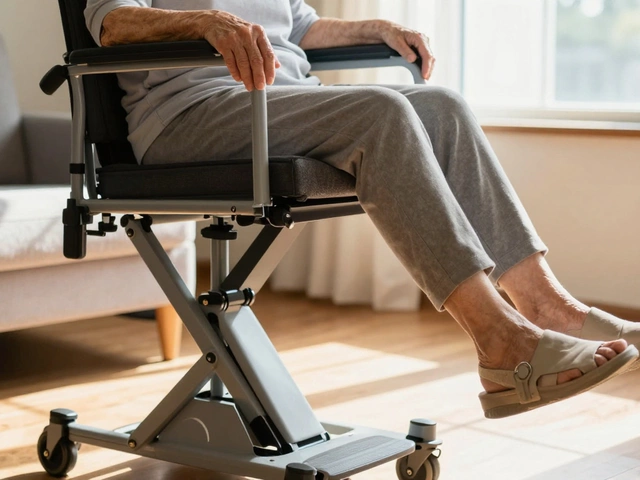Ever notice your belly looks bigger the moment you sit down? You’re not imagining it. When you slouch or collapse into your chair, your core muscles switch off and your stomach naturally spills forward. People can spend more than nine hours a day sitting—especially if you’ve got an office job in Mississauga, rain or shine. The good news? Tiny tweaks to how you sit can make your core work harder, even while you’re answering emails.
It’s not about doing sit-ups at your desk. In fact, basic things like sitting up straight with your feet flat on the ground, shoulders relaxed, and your back slightly arched can make your abs do more just by holding you up. Think of your torso like a soda can—you want it tall and sturdy, not crushed and floppy. Being mindful about your posture isn’t just about looks, either. Studies from the University of Waterloo have found that folks with better lumbar support and upright posture actually use 30% more core muscle activity. So, your office chair picks sides in this battle. Don’t give it the day off.
The trick is to combine these little posture hacks with a few easy moves you can sneak in while you work. Ready to dial up your ab game without anyone at the office noticing? Keep reading.
- Why Your Stomach Sticks Out When You Sit
- Posture Hacks That Tighten Your Core
- Cheat Sheet: Movements and Micro-Exercises
- Picking the Right Office Chair for a Flat Stomach
Why Your Stomach Sticks Out When You Sit
You plop down in your office chair and—bam—your stomach suddenly wants to say hello. This isn't just about gaining a few pounds over winter. A flatten stomach is harder to keep when you’re sitting because your core muscles relax, your hips roll forward, and your gut has nowhere to go except out. Even skinny people deal with this.
Here’s what’s going on: when you sit, especially with bad posture, your abdominal muscles basically check out. Your spine tilts and your pelvis tips forward (it’s called anterior pelvic tilt). This creates that belly-bulge look. Over time, the muscles get weaker, so the stomach sticks out even more. Add tight hip flexors from endless hours at a desk and you’ve got an even bigger problem. That’s why it often feels like your stomach looks flatter when you stand or walk compared to sitting at your computer.
Your office chair also matters way more than people think. Chairs without support force your body to compensate in all the wrong ways—basically, you’re scrunched in half, and your abs take the day off. Ergonomic research at Cornell University found that sitting with no lumbar support increases pressure on your belly and spine by up to 60%. Ouch.
| Position | Core Muscle Use (Compared to Standing) |
|---|---|
| Slouched Sitting | 15% |
| Upright Sitting | 35% |
| Standing | 40% |
If you can see your stomach pushing out while you’re sitting, it’s not just you—it’s science. The mix of lazy abs, slouched spines, and chairs that don’t help makes it tough for anyone to keep things tucked in.
Posture Hacks That Tighten Your Core
It’s wild how much your posture can impact your stomach. Slouching compresses your abs and makes everything stick out more. Want your stomach to look flatter without leaving your chair? It’s all about how you sit—and it doesn't have to feel stiff or unnatural.
First off, let your feet sit flat on the floor. Don’t cross your legs for hours. Sitting with your knees at a 90-degree angle lets your lower back line up properly, so your core doesn’t take a nap. Rest your shoulders back and let your arms hang easy—don’t hunch them up to your ears.
Try this: Imagine there’s a string gently pulling you up from the crown of your head. Feel your spine lengthen. As weird as it sounds, this trick automatically makes you use more core muscles, especially the deep ones right behind your belly button.
- Sit back in your office chair so the bottom of your shoulder blades touch the chair’s backrest.
- Keep a small arch in your lower back—a rolled towel can help if your chair is flat.
- Don’t stick your chin out; keep your ears in line with your shoulders.
- Once every hour, reset by gently pulling your belly button towards your spine for 10 seconds. This moves your core from cruise control to active mode, burning a bit more each day.
Even subtle awareness matters. A 2022 study from McMaster University in Ontario showed core muscle activity jumped by 20% when people simply kept their spine straight during regular desk work. That’s free toning without any sweat.
| Posture | Core Activation (%) |
|---|---|
| Slouched | 15% |
| Upright | 35% |
The bottom line? Good posture isn’t just about comfort or looking pro at your cubicle. It can help flatten your stomach while sitting—even if you’re grinding through spreadsheets all afternoon.

Cheat Sheet: Movements and Micro-Exercises
Staying in one position glued to your office chair will slow down your metabolism and let your belly flop outward. But you don’t have to get weird looks from coworkers by busting out full planks under your desk. Instead, use these micro-moves to kick your core into gear—most people won’t even notice you’re doing them.
"Even while sitting, you can recruit your abdominal muscles just by keeping your upper body active and avoiding the classic rounded slump we’re all guilty of," says Dr. Stuart McGill, spine biomechanics expert at the University of Waterloo.
Here’s a quick-hit list of moves you can fit right into your workday. You can do them while waiting for a Zoom meeting to load or just spacing out after lunch:
- Seated Stomach Tighteners: Sit up tall with both feet flat on the ground. Pull your belly button in toward your back and hold that squeeze for 10 seconds. Let go, then repeat 10 times. You’re literally flexing your abs on demand—no crunches needed.
- Knee Lifts Under Desk: Stick to the edge of your seat. Hold the sides of your office chair, then lift your knees about an inch off the floor. Lower them after a few seconds. Do 10 to 15 lifts. This wakes up your lower abs way better than just glancing down at them.
- Oblique Twists: Cross your arms over your chest. Gently twist your torso left and right (don’t force it—keep it comfy). Aim for at least 10 twists each way. It acts like a mini massage for your waistline.
- Seated Marches: March your feet in place (one after the other), keeping your knees high. It gets your blood moving and your abs stabilizing everything up top.
- Pelvic Tilts: Push your lower back slightly into the chair, then arch it forward, rocking your pelvis back and forth. It’s subtle but wakes up your core muscles and keeps your hips from getting stiff.
These add up. Guys who fit in a handful of these moves see a difference in their energy, focus, and even posture by the end of the week. A cool stat? A Canadian workplace study published in 2023 found that people who practiced these micro-movements burned up to 150 calories more per day compared to those who sat still.
| Micro-Exercise | Calories Burned/Hour* |
|---|---|
| Seated Stomach Tighteners | 18 |
| Knee Lifts | 22 |
| Oblique Twists | 15 |
| Seated Marches | 28 |
| Pelvic Tilts | 12 |
*Based on moderate repetition; actual burn varies by body size and movement intensity.
Don’t overthink it. Doing a couple sets every hour or so keeps your flatten stomach mission on track, and makes sitting all day way less of a drag.
Picking the Right Office Chair for a Flat Stomach
If you’re serious about flattening your stomach while sitting, your office chair can help or hurt your progress. A chair that lets you slump or doesn’t support your lower back will only make your belly pooch out more. That’s why picking the right office chair really matters for anyone who wants to tame their midsection as they work.
First, focus on lumbar support. According to ergonomics experts at Cornell University, a chair with good low back support keeps your spine in its natural curve. This makes your core muscles fire automatically to stabilize you. Cheap or worn-out chairs often lack this, so your abs basically get the day off—bad news if you’re aiming for a flatten stomach effect.
Adjustability matters a lot too. The best chairs let you tweak seat height, backrest angle, and armrest position. That way you can sit with your feet flat on the floor, knees at hip level, and your body relaxed—not hunched or craned. When your chair fits your body, your abs have zero excuse to slack off.
Ever tried a stability ball chair or a kneeling chair? These aren’t just for the flex office crowd. Sitting on a balance ball (even for short bursts) makes your core work overtime to keep you upright. A kneeling chair tilts your hips forward and stacks your spine, encouraging you to use your stomach muscles instead of your back. If your work allows it, mixing these in throughout the week can give your abs a subtle but real workout.
- Lumbar support: Keeps your back in shape and activates your core.
- Adjustability: Seat height, backrest, and armrest changes help you sit smart and comfortably.
- Stability options: Swapping in a balance ball or kneeling chair for part of the day keeps your abs active.
If you want numbers, look at this quick stat table pulled from a 2023 Canadian office seating survey on support and comfort:
| Chair Feature | % Users Reporting Better Core Engagement |
|---|---|
| Solid lumbar support | 68% |
| Adjustable seat/back/armrest | 60% |
| Stability ball chair use | 56% |
So if you’re just sitting on an old, saggy chair, you’re fighting an uphill battle. Upgrade your office chair to something that lets your abs join the action—even when you’re working through a stack of paperwork or a Zoom marathon.







